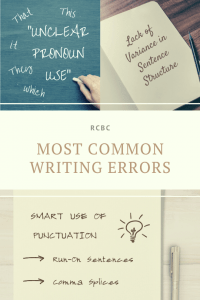By Communication Consultant Carolyn Reagan (Undeclared, ’23)
 When it comes to writing, there are a number of mistakes that are prevalent and greatly undermine effectiveness, clarity, and cohesiveness. This piece is part of our ongoing series about common writing errors.
When it comes to writing, there are a number of mistakes that are prevalent and greatly undermine effectiveness, clarity, and cohesiveness. This piece is part of our ongoing series about common writing errors.
One way to ensure your readers understand your ideas is to prioritize clarity in your pronoun use. We use pronouns to refer to a recently-mentioned noun (a person, place, thing, or concept). Pronouns help limit repetition in writing. They are an important component of speech in both English and other romance languages. Some common pronouns are “I,” “her,” “you,” “we,” “they,” and “him.”
For instance: “Melinda and I are working together on a marketing project. She is responsible for designing the Powerpoint.”
In the case of this simple sentence, it is clear that the pronoun “she” is referring to Melinda. The use of “she” also helps prevent the unnecessary repetition of Melinda’s name. Most frequently, pronouns referring to a particular person or group of people are used in a very similar capacity. However, not all pronoun usage is as straightforward. The pronouns “this,” “it,” “that,” or “they” are susceptible to being used in an erroneous manner. If they are used incorrectly or not clarified, they can become incredibly confusing.
For example: “Wordsworth greatly revered the natural world, writing about the way that the sublime and individualism manifest themselves in daffodils, clouds, and landscapes. This made him one of the most important poets of the Romantic era.”
As a general rule, the pronoun “this” should almost always be followed by a noun that clarifies what you are referring to (i.e.: This “case,” “decision,” or “approach”). The above sentence is confusing in large part because of the pronoun “this.” It is near impossible to understand what “this” refers to; is it describing Wordsworth reverence of the natural world, his choice to write about the sublime and individualism, or his actual writing? The subject could easily be clarified by instead writing “This focus…” A similar shortcoming is present in the following example.
For example: “When Camus writes about Meursault’s rejection of the Chaplain’s request, it means that he does not believe in religion.”
The above sentence has two examples of ambiguous pronoun usage. It is unclear what the word “it” is referring to in the antecedent of the sentence. Additionally, the word “he” could potentially be referring to Albert Camus, the author, or Meursault, the book’s main character. Though the sample sentence presents an intriguing point, its confusing pronouns undercut its comprehensibility. Complex sentences (like the sample) that have a combination of both independent and dependent clauses can add important variety to an essay, but can simultaneously present grammatical difficulties.
When it comes to pronouns, the easiest rule to follow is this: A pronoun logically refers to the most recent noun that matches in number and gender.
In general, the best way to avoid unclear pronoun usage is by thoroughly reviewing and rereading your work prior to submitting it for a grade. Also, consider asking a friend or peer to double check your work. Of course, the RCBC Communication Consultants can look over your writing with you to help identify any issues with pronouns. Clear pronoun use will ensure your readers can fully understand your thoughts and ideas while writing.
Get information and resources about our center at The Philip Rauch Center for Business Communication.
